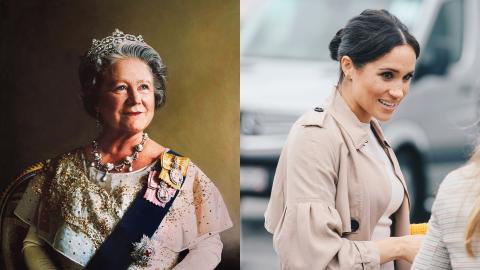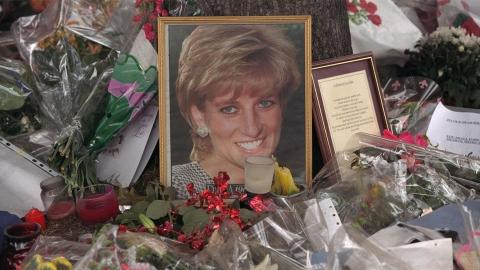
The life of Queen Victoria: A queen in a man's world
Image: Victoria photographed by J. J. E. Mayall, 1860 - colourised (Public Domain)
Queen Victoria:
Born: 24 May, 1819, Kensington Palace
Died: 22 January 1901 (aged 81) Osborne House, Isle of Wight
Reign: 20 June 1837 – 22 January 1901
Despite monarchy being largely constitutional at the start of Queen Victoria’s ascension, her 63-year reign saw her preside over the abolition of slavery, the expansion of workers’ welfare, the speedy innovation of industrial engineering and the invention of the telephone.
Behind the famous image of the stout old lady in black, Victoria was a passionate romantic woman who was frequently amused.
Woman in a man’s world: The prime ministers loved and detested
Queen Victoria was never meant to rule. She was the fifth in line to the throne and became heir presumptive to her uncle George IV after both her father, Prince Edward and grandfather King George III died within a year of each other.
Brought up in a world of manipulative men, Victoria married a controlling husband, Prince Albert at just 21 years of age. Victoria’s formidable personality saw her undergo a battle of wills with guardians and politicians from the day she became Queen. One of the first men Victoria found herself in conflict with before ascending the throne was her advisor Sir John Conroy, who conspired with the young princess’ mother the Duchess of Kent, to gain influence once Victoria became Queen.
Lord Melbourne (William Lamb, 2nd Viscount Melbourne) was Victoria’s first prime minister in 1837 who greatly influenced her, coaching the young Queen in ways of politics and who became a trusted friend. The friendship was formed through Melbourne’s wit, fatherly attitude, and ability to make the young Victoria laugh, a skill she admired in men. It was this quality, Victoria appreciated in her seventh prime minister Benjamin Disraeli, a Conservative politician whose ideological views of expanding the British Empire were popular with both the queen and the public.
The theatrical statesman treated Victoria as an equal, demonstrating deference as well as a surfeit of charm and an inclination to gossip which the Queen loved. Conscious of Victoria’s diminutive stature Disraeli even had the feet of a dining table chair at his private Buckinghamshire home sawn down by two inches, so that the royal feet wouldn’t be left dangling.
Despite the image of Victoria as an emblem of emotional constraint and propriety, the Queen disliked reserved people. The buttoned-up liberal Prime Minister William Ewart Gladstone, who succeeded Disraeli and served Victoria from 1868 for 12 years over four consecutive terms, was a man she particularly loathed. Victoria saw Gladstone as a threat to the monarchy itself. She wrote in her diary ‘Mr Gladstone is a very dangerous man and so very arrogant, tyrannical and obstinate with no knowledge of the world or human nature’. When Gladstone stayed at Balmoral neither the Queen nor Gladstone could stand the idea of talking to each other and instead corresponded by heated letters despite occupying the same building.
Mourning to emancipation
In 1861 the deaths of Queen Victoria’s estranged mother and husband Prince Albert left her distraught, and she left London to escape into a self-inflicted prison of solitude. Widowed aged 42, she turned her delirium into an extreme form of hero-worshipping, turning Prince Albert, a man she often battled with, into a demigod. Even her grown-up children were dragged into her orbit of morbid mourning, forcing them to visit the room their father died in on every anniversary of his death.
Victoria’s marriage to Albert had infantilised her as she relied on him for everything, whether seeking Albert’s approval for what dress she should wear to daily political decisions. After Albert’s death, Victoria was finally free and able to become her own woman. Her journey to liberation began in her favourite German town of Coburg in Bavaria, a place where her German lineage from the House of Saxe-Coburg-Gotha had its roots and where she felt most at home. The region of Saxe-Coburg was also the birthplace of her husband Albert and her mother Princess Victoria. In Queen Victoria’s journal, she confessed her love for Germany. ‘If I were not who I am my real home would be here’.]
Victoria the mediator: Germany v Prussia
Before 1871 Germany was not a unified country but a series of small Duchy city-states in need. Victoria was worried that the German regions would be bullied by the northern kingdom of Prussia to become a militaristic nation rather than a peaceful federation.
In the summer of 1863 Queen Victoria, in her first diplomatic role since the death of Albert, attended a gathering of the rulers of both Prussia and Austria. In the same hall where her parents were married, she met the Emperor of Austria Franz Joseph and they drank a toast to the unity of Germany.
As an independent monarch, she negotiated on behalf of England and a peaceful Europe. She acted as an arbiter between two rival kingdoms led by William I of Prussia and the Emperor of Austria and succeeded in carrying out her late husband’s political work on her own to unify Germany. Rather than shutting herself away in a world of funereal indulgence as the English newspapers saw her, Queen Victoria was becoming intimately involved in European politics.
Platonic love affair: John Brown
From being a young woman who was orphaned as a child Victoria had always sought father figures. At 45-years-of-age Victoria’s next ‘devoted soul’ and of whom she wrote in her journal longing to be ‘taken care of’, was in the form of Prince Albert’s Highland manservant, Mr John Brown.
The gruff, bearded, and straight-talking tall Scotsman was brought down from Balmoral to attend Victoria at Osborne House on the Isle of Wight in 1864. Some historians believe that Brown’s company at Osborne, beginning ten years after the death of Prince Albert, kept the depressed Queen sane. The still mourning Victoria found laughter and fun in her life again due to Brown’s company.
The Queen’s love of Scotland contributed to her fondness for the unmarried and kilted Brown, who was the only person allowed to carry and hug her. She loved the down-to-earth humour of Brown, in contrast to the stuffiness and decorous attitudes of her aristocratic brethren and royal aides.
During his 18 years of service to the Queen, Brown became her closest companion and best friend before his unexpected death at Windsor Castle from a bacterial infection in 1883. Queen Victoria wrote to Brown’s sister-in-law ‘He was the best, truest heart that ever beat,’. Later the bereft Victoria wrote in her journal ‘The comfort of my daily life is gone—the void is terrible—the loss is irreparable!’
Scandal: Queen Victoria’s published journals
Years before the confessionals of modern royals and in particular Lady Diana Spencer, Queen Victoria, a woman known for shying away from the public, decided to share her thoughts in published extracts of her private diaries. ‘Leaves from the journal of our life in the Highlands’ came out in 1868 and was an instant best seller.
The journals sold over 100,000 copies with John Brown depicted as its hero, while Victoria’s children got scant attention. Eldest daughter, Princess Vicki of Prussia felt her mother’s published adoration of John Brown was scandalous. In New York, a scurrilous pamphlet titled ‘John Brown’s Legs’ showed a cartoon of the Queen attending to Brown’s damaged knee.
A potential third journal and biography of John Brown prompted the horrified court and politicians to step in and request Victoria to put down her pen on the grounds that the books were ‘inappropriate’ and likely to suggest that her friendship with Brown could be misconstrued. Victoria’s children, in particular Princess Beatrice, deleted all reference to John Brown in her mother’s memoirs.
The Empress of India
The exotic title bestowed on Queen Victoria was part of Prime minister Disraeli’s plans for Victoria to become a symbol of British power, both at home and across the world. Disraeli announced that Victoria was the Empress of India on the 1st of January 1877. She was delighted with the new title which made Britain an imperial power and created the impression the country was rich in the eyes of the public.
For eighty years the ‘Empire’ was the pride of Britain’s Conservatives and the envy of many beyond its borders. The title was a publicity coup in India where millions saw Queen Victoria almost as a goddess figure, even though she never visited the country in her entire life.
The Golden and Silver Jubilees
In 1887 at 68-years-of-age, Queen Victoria celebrated her Golden Jubilee. Free from her past with her beloved Albert, the Queen’s newfound zest for life and ruling a global population was characterised by her recreating a wing of Osborne House on the Isle of Wight as the Durbar Room, a celebration of Indian architecture and culture.
Victoria was at the height of popularity again as she marked the fiftieth anniversary of her accession with a banquet inviting fifty kings and princes. Nine years later, marking her Diamond Jubilee on 22 June 1897 the public’s affection for Victoria was still as strong. The Jubilee procession followed a route six miles long through London. The 78-year-old Queen paused in front of vast cheering crowds in an open carriage outside St Paul’s to avoid having to climb the steps to the building.
Four years later after a lengthy period of failing health, rheumatism and deteriorating eyesight Queen Victoria, Empress of India died on 22 January 1901 at Osborne House.























